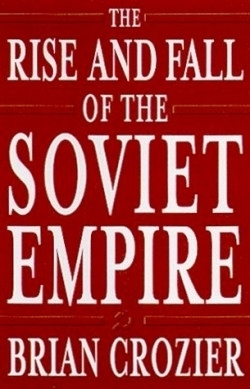The Rise and Fall of the Soviet Empire
Ten years after the fall of Communism, Lenin’s body still lies under the Kremlin, looking dapper, if a bit creepy, in its perfectly trimmed goatee and shiny, chemically-preserved skin. He looks ready to rise and rally his revolutionaries once again. Lenin’s revolution is dead, however, and this book
tells the stories of how it lived and died in the countries outside the Soviet Union that flirted with its romance and cruelty.
Crozier, a Distinguished Visiting Fellow at the Hoover Institution and former advisor to Margaret Thatcher as well as the CIA, has compiled massive amounts of research, including recently unveiled sources from Russian archives, to tell the story of Soviet expansion and collapse around the world. He relates again Lenin’s “bloodthirsty revolutionary fantasy” of world domination, showing how Lenin intended to spread his version of Marxist ideology by any means possible. “Revolutionaries who are unable to combine illegal forms of struggle with every form of legal struggle,” Lenin wrote, “are very bad revolutionaries.”
Crozier gives quick sketches of the Soviet Union’s involvement in forty some countries. Especially interesting is his description of the relationship of Mao Tse Tung with Stalin. For a while, Mao and Stalin worked together on friendly, even jocular terms. Stalin, however, ultimately mistrusted Mao, refusing not only to provide him with planes for the Korean War, but also (fortunately) to give him nuclear weapons. Mao in turn tried to undermine the Soviet Union by appealing to racism, urging African nations to side with China and other “non-whites.”
Castro had his falling out with Krushchev. For a while, the Russian leader tolerated Castro by, for example, providing means for him to earn money publishing articles and speeches in the Soviet Union. But the relationship wore thin when Castro started exporting his own brand of revolution. When the Cuban economy collapsed he had no choice, but to turn to Moscow, and in exchange for help he thereafter toed the Soviet line.
The writing in the book is not artful, making it somewhat laborious to read. Politically, Crozier is clearly from the right wing. The book, however, is well researched, and for anyone who wants a thorough look at where Lenin’s revolution touched the world outside the Soviet Union, Crozier has provided an excellent resource. (December 1999)
Reviewed by
Keith Collins
Disclosure: This article is not an endorsement, but a review. The publisher of this book provided free copies of the book to have their book reviewed by a professional reviewer. No fee was paid by the publisher for this review. Foreword Reviews only recommends books that we love. Foreword Magazine, Inc. is disclosing this in accordance with the Federal Trade Commission’s 16 CFR, Part 255.

